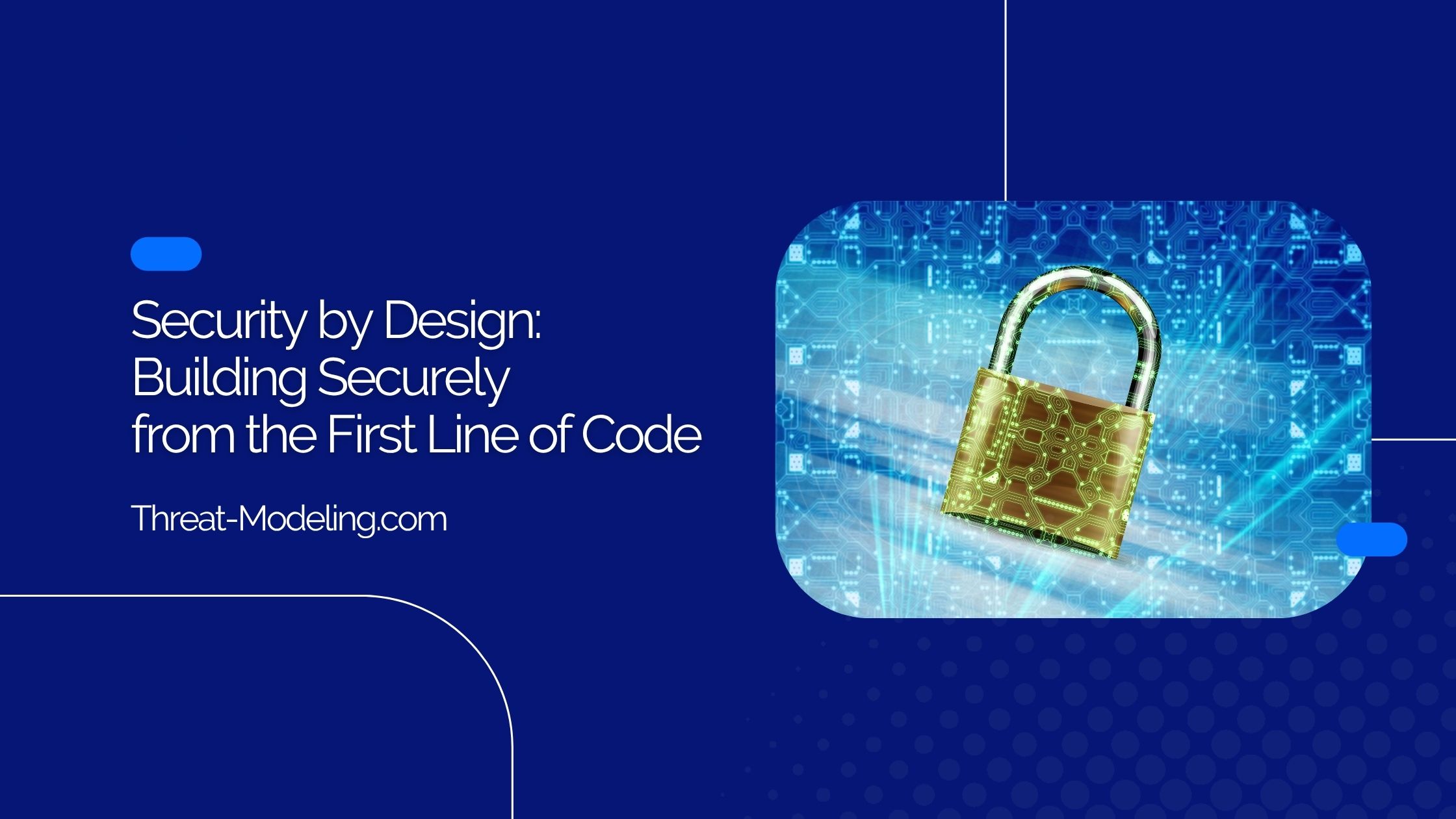Opening the Door to a Safer Digital World
Security by Design has become one of those phrases that people sprinkle into presentations, yet it is far more than a buzzword. It is a philosophy, a process, and when done well, a mindset that reshapes how teams build and maintain software. Instead of treating security as a patch or an afterthought, Security by Design places protection at the core of every architectural choice, every user story, and every line of code. In today’s threat-heavy landscape, that shift is no longer optional. It is vital.
What Is Security by Design in Cybersecurity?
At its simplest, Security by Design means embedding defensive measures from day one. Think of a home with reinforced doors, shatter-proof windows, and a pre-installed smart alarm system. You would feel safer living in that house than in one where locks were added months later. Software works the same way. When security comes baked into the foundation, attackers have fewer cracks to exploit, and users gain peace of mind.
Unlike reactive security models, where teams scramble to fix bugs after a breach, Security by Design starts with a proactive stance. The development process becomes guided by three core ideas. First, be sure to anticipate threats early. Second, reduce the attack surface wherever possible. Third, validate that controls remain effective over the product’s lifetime. These principles echo across cloud platforms, mobile apps, embedded firmware, and large AI models. No domain gets a free pass from risk, so no domain should ignore this approach.
How to Perform Security by Design: Principles into Practice
Turning theory into practice demands more than good intentions. Teams must adopt a disciplined workflow that nudges everyone, including architects, product owners, UX designers, and QA testers, to secure decision-making.
The journey often begins with clearly defined security objectives. For example, a fintech startup might prioritize transaction integrity, while a healthcare platform focuses on patient confidentiality under HIPAA. Setting goals clarifies which controls matter most.
Once objectives are in place, clear design guidelines help translate strategy into everyday decisions. Developers can lean on proven frameworks such as the secure coding standards by OWASP or CERT. These references act like safety rails, steering coders away from common pitfalls such as SQL injection or cross-site scripting. Regular code reviews build another layer of defense, because fresh eyes catch mistakes automated scanners might overlook.
In many organizations, culture can be the hardest part to change. Engineers often measure progress in features delivered, not vulnerabilities avoided. To shift that metric, leadership needs to reward secure habits. Recognizing individuals who spot and fix weaknesses, even if it slows a sprint, sends a clear message: quality outranks speed. Over time, secure behavior becomes routine, not exceptional.
Threat Modeling: The Compass of Security by Design
No ship sets sail without a navigation plan, and no product should ship without a clear understanding of its threats. Threat modeling serves as the compass that guides Security by Design efforts. The process can feel intimidating, but at its heart, it contains four steps: identify what you are building, map potential attackers, analyze weaknesses, and prioritize defenses. Whether one uses the popular STRIDE framework or a customized variant, the value remains the same, seeing the system through an attacker’s eyes.
Consider a social media platform introducing live video chat. The developers must ask: Who could abuse this feature? What data crosses the wire? Where does it get stored? Might someone inject malicious content? By whiteboarding data flows and user scenarios, the team surfaces risks early, when they are still cheap to fix. A typical outcome may include stronger input validation or end-to-end encryption baked directly into the design.
Threat modeling should not be a one-time exercise. As features evolve and new integrations appear, fresh threats emerge. Integrating periodic threat reviews, say, at each major release, keeps defenses aligned with reality, not yesterday’s assumptions.
The Phases of Security by Design
Although every organization tailors its workflow, Security by Design generally moves through five interconnected phases. Everything starts with requirements. Clear security requirements, aligned to business goals and regulations, anchor the project. Next comes design, where architects translate those requirements into technical controls, choices such as role-based access or encrypted storage.
The third phase is implementation. Here, secure coding standards and peer reviews reduce the odds of introducing exploitable bugs. Fourth is verification, where static analysis, dynamic testing, and penetration exercises confirm that controls work as intended. Finally, there is maintenance. The industry sometimes calls this phase “secure operations.” Patching, monitoring logs, and responding to incidents keep the system resilient as threats and dependencies shift.
These phases reinforce each other. A requirement missed early forces an expensive redesign later. A testing gap may leave weaknesses that attackers exploit in production. A mature Security by Design practice treats each phase as mandatory, not optional.
Including Security by Design in the Software Development Lifecycle (SDLC)
The standard Software Development Lifecycle already contains familiar stages: requirements, design, implementation, testing, deployment, and maintenance. Security by Design augments each stage rather than replacing any. In agile settings, this means threading security tasks into every sprint, not isolating them in a separate “hardening” release. In a waterfall project, security checkpoints align with each macro milestone.
For example, during backlog grooming, user stories receive explicit acceptance criteria tied to security. During sprint planning, tasks such as “add input validation” or “update threat model” earn story points alongside new features. During daily stand-ups, blockers like an unresolved vulnerability are surfaced immediately. At the end of a sprint, the Definition of Done includes clean results from automated security tests.
DevOps accelerates this rhythm further. Continuous integration pipelines can run static application security testing after every commit. Container scans catch vulnerable base images before they reach staging. Infrastructure-as-code definitions carry policies that prevent insecure port exposure. When pipelines fail fast, issues remain small and contained.
AI in Security by Design: Friend, Foe, and Force Multiplier
Artificial Intelligence changes the security equation in two distinct ways: it introduces new vulnerabilities, and it offers powerful defensive tools. Let’s tackle each in turn.
First, AI systems, especially large language models and complex neural networks, carry unique attack surfaces. They can leak training data, generate harmful content, or be manipulated through adversarial prompts. Embedding Security by Design means modeling these specialized threats from the start. Data anonymization, robust content filters, and rigorous permission controls must be integral to every AI pipeline.
On the defensive side, AI acts as a force multiplier. Machine learning models can spot anomalies in network traffic faster than human analysts. Natural-language processing can triage log data, highlighting suspicious patterns before they escalate. Even code reviews can benefit: AI-powered tools now suggest secure refactors and flag vulnerable snippets in real time. Integrating such technology into the SDLC accelerates detection and raises coding quality without adding headcount.
Yet AI is not magic. False positives remain a concern, and attackers continuously adapt their tactics. A balanced approach combines human judgment with machine speed. Regular model retraining, transparent explainability, and ethical guardrails ensure AI stays an ally, not a wildcard.
Human Factors: Because People Still Hold the Keys
Technology alone cannot guarantee success. Social engineering remains one of the most common attack vectors. A well-designed application can still fall to a phishing email if an administrator hands over credentials. Security by Design addresses this reality by weaving education and usability into the fabric of a system.
For instance, multi-factor authentication reduces reliance on passwords, but only if it is user-friendly. Clear error messages guide users away from risky clicks. Accessible security dashboards give ops teams the insight they need without drowning them in noise. Every design decision, from color schemes on warning banners to the length of session timeouts, can influence user behavior. By thinking like psychologists as well as engineers, teams create systems that support safe choices instead of demanding superhuman vigilance.
Regulation and Compliance: Turning Mandates into Momentum
Digital products seldom live in a regulatory vacuum. From GDPR and CCPA to PCI-DSS and SOX, compliance frameworks dictate baseline protections. Security by Design aligns naturally with these mandates because it internalizes controls early, rather than retrofitting them under deadline pressure. A developer who encrypts personal data by default is ahead of the curve when auditors arrive. A product manager who tracks data flows meticulously can generate compliance reports at the click of a button.
This synergy not only avoids penalties; it can unlock new markets. Many enterprises require vendors to pass rigorous security assessments before signing contracts. Demonstrating a mature Security by Design program signals credibility and opens doors.
Continuous Improvement: Measuring What Matters
No process stays perfect forever. Continuous feedback closes the loop. Metrics such as mean time to remediate vulnerabilities, percentage of code covered by static analysis, or number of high-severity findings per release provide hard data. Security champions can use these numbers to spot trends and allocate resources. Perhaps the team needs more training on secure authentication flows, or maybe automated tests lag behind evolving APIs.
Post-incident reviews also play a key role. When a breach attempt occurs, dissecting the event uncovers where processes broke down—whether a missing alert, an outdated dependency, or human error. Feeding those lessons back into the requirement phase tightens the entire SDLC. Over time, organizations shift from reacting to predicting. That is the hallmark of a mature Security by Design practice.
Case Study Snapshot: Start-up to Scale-up
Consider a fictional SaaS start-up called NimbusNote. In its early days, the founding engineers pushed code straight to production. After winning a large enterprise client, compliance questionnaires exposed gaps. The team adopted Security by Design. First, they ran a threat model workshop, uncovering risks in their file-upload feature. They added antivirus scanning and content-type validation. Next, they embedded static code analysis in their CI pipeline and created a culture of peer reviews with security checklists.
Three months later, NimbusNote launched an AI-driven search feature. Applying their new mindset, they anonymized training data and implemented prompt-injection filters. When a penetration test probed the platform, only minor issues surfaced, all fixed within a sprint. These quick wins impressed investors and accelerated their Series B funding. The story underlines how Security by Design not only prevents loss but also drives growth.
Looking Ahead: The Future of Security by Design
As quantum computing inches closer, encryption schemes will face fresh challenges. IoT deployments continue to expand the digital footprint, blending software with physical safety. Meanwhile, AI models become more autonomous, turning decision-making into a shared space between humans and algorithms. In each of these arenas, the principles discussed here hold steady. Build with risk in mind, validate continuously, and adapt swiftly.
The tools will evolve. We may soon see fully autonomous DevSecOps pipelines that patch themselves or AI pair programmers fluent in secure coding patterns. Yet the essence remains unchanged: intentional design choices deliver stronger protection than last-minute fixes. Organizations that internalize this lesson will thrive in tomorrow’s threat landscape.
Final Thoughts
Security by Design empowers teams to create software that users can trust. By shifting left—placing security concerns at the very beginning of the development journey—organizations minimize risk, cut long-term costs, and build reputations for reliability. From threat modeling and phased verification to AI-enhanced safeguards, the techniques outlined here form a cohesive strategy. Embrace them early, refine them often, and you will find that robust security and rapid innovation can and should coexist.


